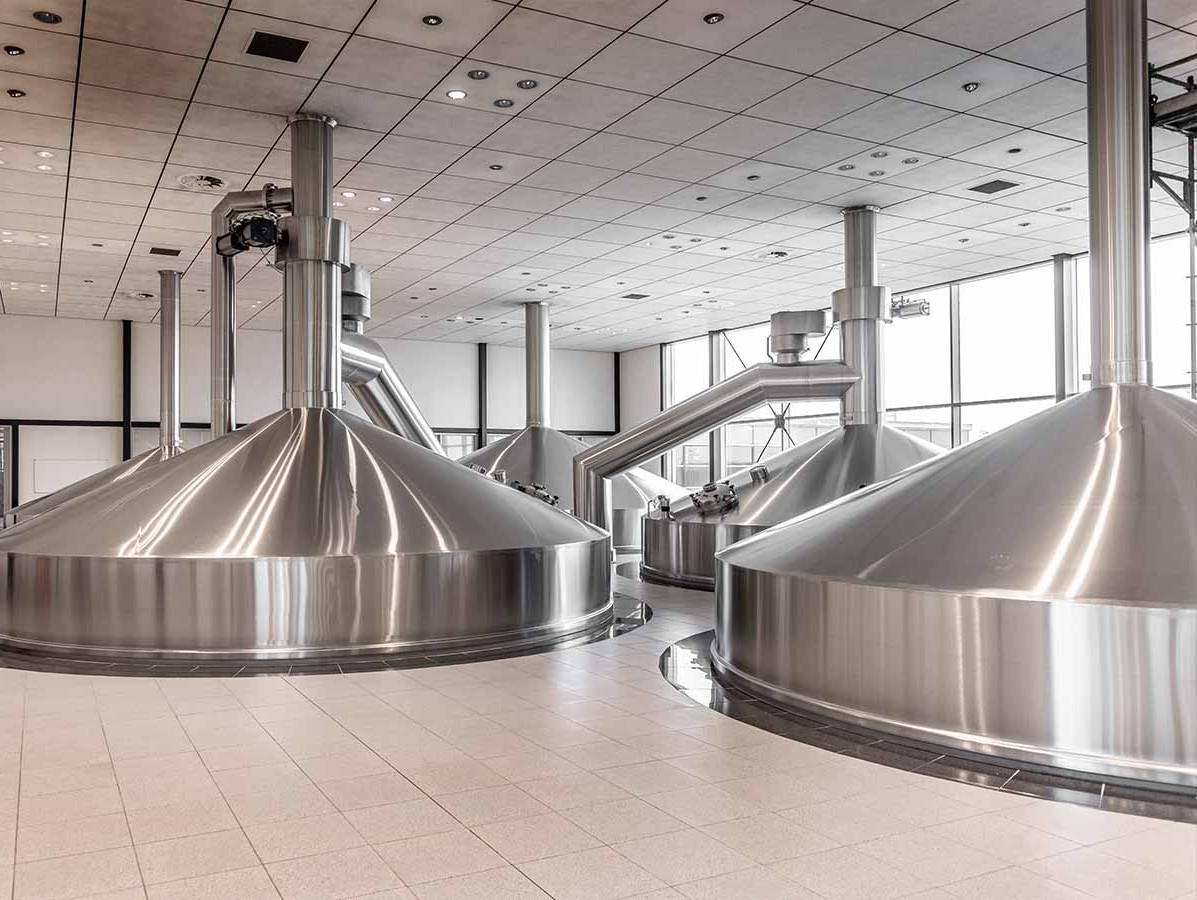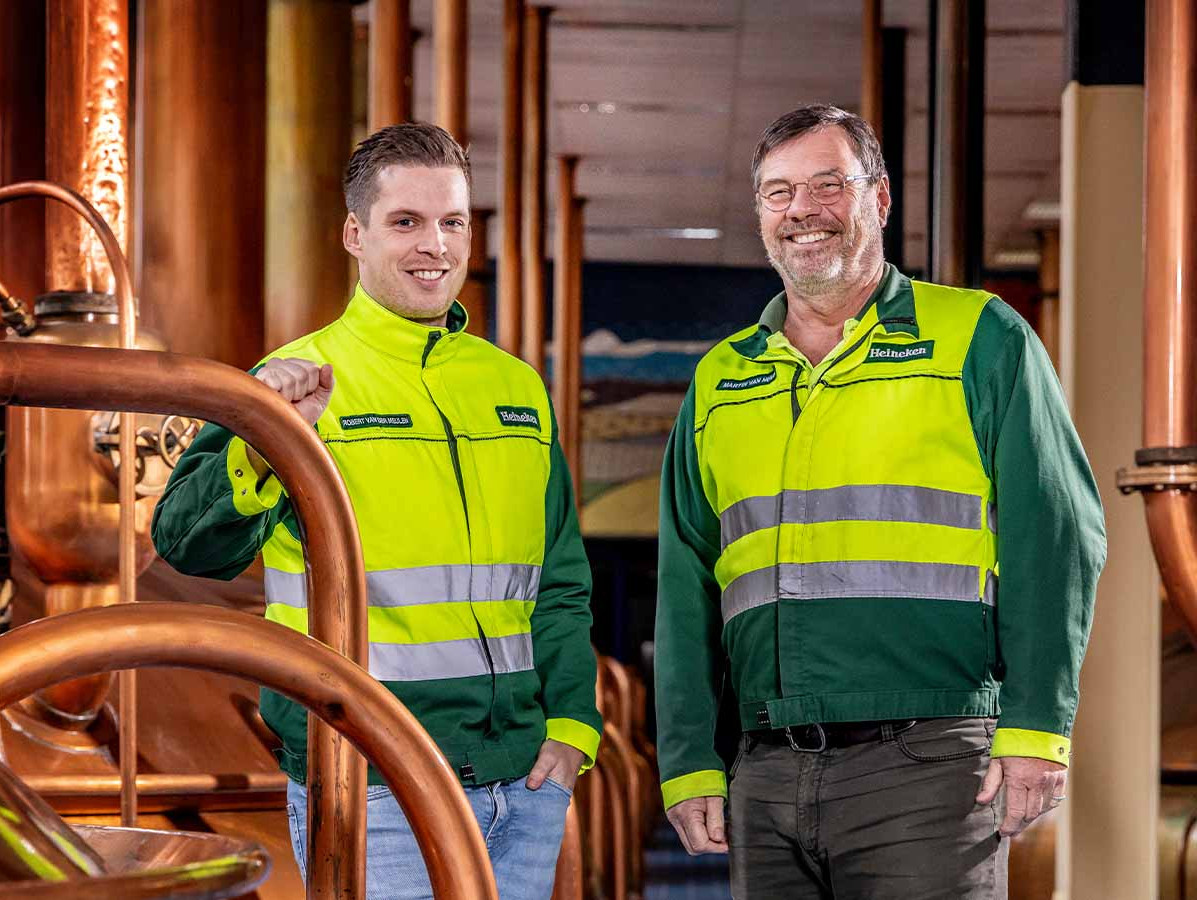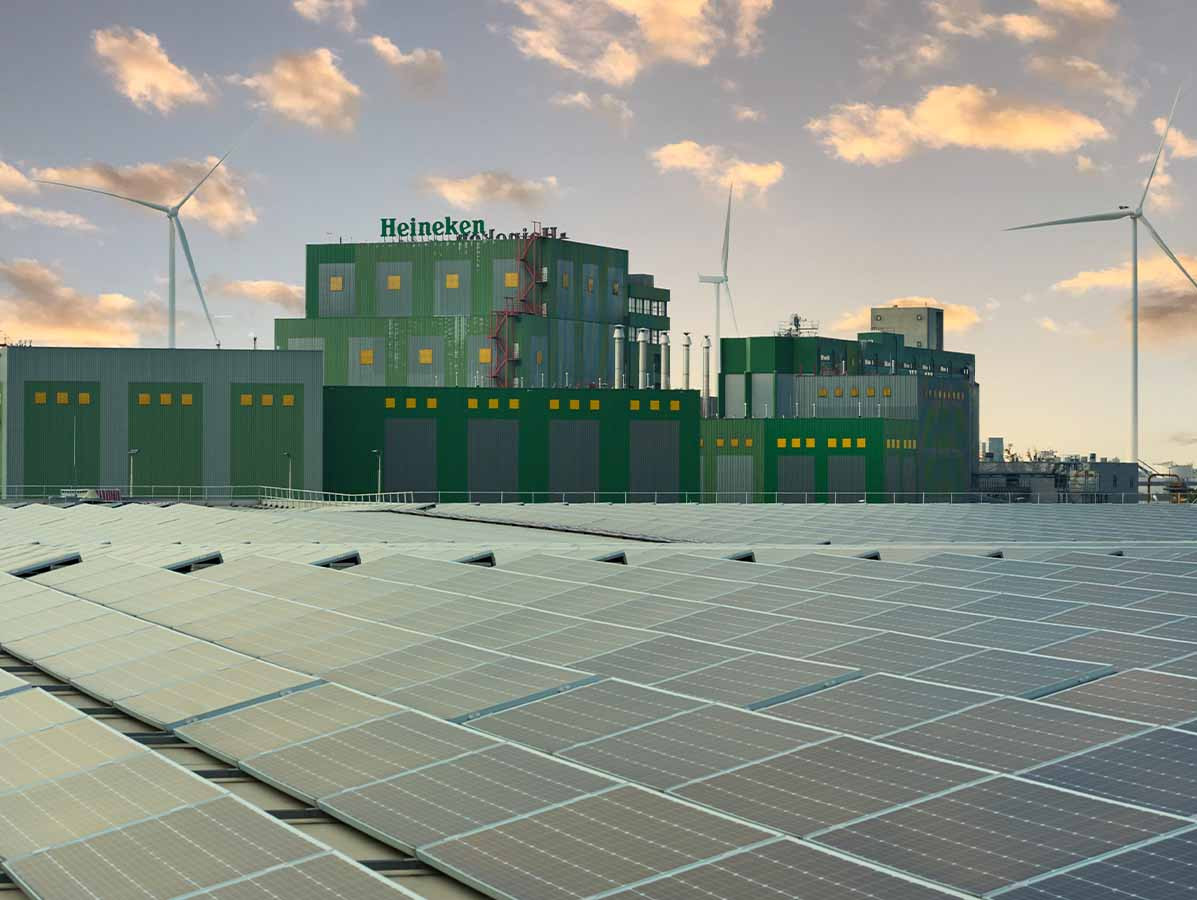
How do you make a brewery sustainable that was built in a time when water and energy were hardly costly, and the use of double glazing was a rarity? Nowadays, at the Heineken Brewery in Den Bosch, operational since 1958, approximately 6 million hectoliters are brewed annually, roughly 1,000 liters of beer per minute. Sustainability of production is a top priority.
The Heineken Brewery in Den Bosch aims to brew with 100% renewable energy by 2027. How do they plan to achieve this ambitious goal? To learn more about it, we talked to Martin van Nuus, Energy and Sustainability Specialist, and his colleague Robert van der Meulen, Compliance & Environment Officer.
In 2021, Heineken elevated its sustainability goals with the introduction of the 'Brew a Better World 2030' strategy, aiming for 'net-zero emissions' across the entire chain by 2040. For the past two years, a special task force, comprising various disciplines, has been fully dedicated to energy and water reduction. Martin, actively involved in the brewery's sustainability efforts since 2012 as a researcher and solution innovator, has passionately committed himself to achieving these goals. Robert, the task force leader, translates Martin's ideas, concepts, and tools to the management since joining the company five years ago, ensuring their actual implementation.
Robert: "When this brewery was established, it was constructed with single-pane glass. Water barely cost any money; they extracted it directly from the ground. Gas and electricity were also extremely cheap. Over the years, installations were interconnected, and processes were replaced. Overall, not an easy starting point for sustainability."
Martin: "Nevertheless, we can achieve a lot. It's like an old car; you can still save fuel with it. Driving nervously consumes much more fuel than using the gas pedal calmly. I view our processes the same way. Sustainability is primarily about optimizing the brewing process. The focus is on the 'Trias Energetica': save, reuse, and bring in renewable sources.

Robert van der Meulen (left) and Martin van Nuus
Martin: "There are 16,569 solar panels on the roofs of this brewery. There are three wind turbines nearby, and the brewery uses biogas. The solar panel park and wind turbines account for 93% of the total electricity demand. The remaining 7% comes from a Dutch wind park elsewhere in the country (figures for the year 2023 in the Den Bosch brewery, editor's note). Regarding gas consumption, more than half of the total amount is currently biogas. From the very moment our wastewater treatment plant was put into operation in 1987, the brewery has been producing biogas as fuel for its processes. Additionally, we partnered with the Aa en Maas water board and the Waste Service of the 's-Hertogenbosch municipality in 2018 for the supply of biogas to this brewery."
"We spent years getting the gas from the sewage treatment plant to our facility. It was quite a hassle to arrange this at that time," reflects Robert. "But we succeeded. The water board produces biogas from wastewater with a sludge digester at the sewage treatment plant and delivers it to the brewery through a biogas pipeline, over 5 million m³ per year.
Martin: "We mix that biogas - which burns less efficiently due to its composition - with our own pure biogas. The blend burns well. Renewable energy is generated with steam boilers: for heating water for the brewing process and for the packaging process."
Robert: "In addition to biogas, we also harness energy recovered from the heat of steam vapors. In the past, the chimneys of the brewing process went straight up, and that heat just disappeared. Now they have a branch and a heat recovery system that allows us to recover more than 90% of the evaporation energy."
Martin laughs. "That's actually the most fun part. Savings can often be achieved with simple, small adjustments. At home, but also in your business."
Robert: "Quality is highly prioritized at Heineken. Therefore, water and energy consumption are almost automatically high; necessary for effective cleaning and brewing. It's a fun challenge to find a healthy balance: using enough water and energy to ensure high quality without wasting unnecessarily."
Martin: "Leaks, for example, are not always visible to the naked eye. A valve can be broken inside. How do you detect that? Where and how do you look for the cause? I observed all the lines: what happens exactly and why it is happening that way? Operators aren’t fools; they have a reason for doing things a certain way. I kept asking them the 'why' question repeatedly; Why do you do it this way? Is that really necessary? One time I ended up in a department where the lights were always on. It turned out that the light switches were in very inconvenient places. I always aim to find the underlying cause of a loss, leakage, or inefficiency and then address it directly. Often, we do things just because we are used to it, or because it was decided that way."
Martin: "It starts with understanding. In the past, I would sometimes get the question: 'nice, your measures, but what does it achieve?' If you don't know what the consumption or loss is, you also don't know what it yields, and the motivation to change is far-fetched. That's why we first installed meters everywhere."
Robert: "Through measurements, we now know exactly where the water, electricity, and energy of each department goes, and what their range is and should be. KPIs have been defined. Then we trained the operators. We taught them to critically examine the KPIs and the process."
Martin: "They now know what to look for and what to observe. For example, I also taught them how to detect a leak. Most of them find their work more enjoyable now."
Robert: "To motivate people to contribute to energy and water reduction, we also initiated a major internal communication campaign. When someone achieved a reduction, we made sure it would not go unnoticed. That person received proof of their reduction, presented by the brewery director, with a photo on our internal social media channel. This happened at least every other week. The changes could be small steps or significant changes resulting in substantial savings. We want to show that everyone contributes to the future vision of this brewery."

During the tour, the men demonstrate more about the practical implementation; we visit the entire process, from wort to beer. From a walkway above a large production hall, I look down, where dozens of conveyor belts crisscross, transporting thousands of bottles and beer cans from filling systems to pasteurization machines, and ultimately to the crates and boxes taking all that beer to its final destination.
Martin points toward a bottle cleaning carousel. Speaking over the clinking of bottles and the noise of the machines, he says, "Look, over there we are working with a group of students to investigate how we can save even more water. And see, further down, we've given insulation blankets to machines to save energy."
He has plenty of ideas, as evident from everything he shows. "The great thing is that we now have permission to realize our plans. That wasn't always the case. With a payback period of 30 years for a sustainability investment, I didn't get everything implemented in the past. That radically changed when gas prices skyrocketed."
"The transit times are considerably shorter," confirms Robert, to continue soberly: "Moreover, current legislation obliges us to become more sustainable."
Martin: "It might surprise you; it's Heineken 0.0. That is currently the beer that consumes the most energy. This is because the alcohol is removed after brewing. But we wouldn't be Heineken if we didn't do our utmost to optimize this process so that it will cost much less energy in the future. However, at present, we can say that all Heineken beer produced for the Dutch market is brewed with 100% renewable energy."
Robert: "We started with a small installation for 0.0, but it took off enormously. The segment is growing and now constitutes 10% of the total production. Nothing is wasted; we want to use the alcohol extracted from 0.0 to produce biogas for steam production."
Martin: "Speaking of not wasting anything; we are also looking closely at our wastewater. Where possible, we intend to reuse it internally before discharging it."
During the tour, I get to learn a lot more: bottles for South Africa are larger, and those for Hawaii are smaller. Bottles destined for foreign countries are generally thinner and lighter, which is advantageous for transport. Martin talks about changeover times and quality controls. And why beer drunk directly from a can tastes more bitter than draft beer. He usually opts for 0.0. "If I ever drink a craft beer, it's an Affligem." Robert prefers pilsner. "Especially Amstel; it has a more pronounced taste. And Texels Skuumkoppe, with hints of caramel and apricot." We are now in the old brewhouse. The impressive copper kettles are no longer in use, but removing them is not an option. "Dismantling costs us more than leaving them in place," explains Martin. Sustainability sometimes tastes bittersweet.
Photos: © Studio 38c
Source: Vakblad Voedingsindustrie 2024